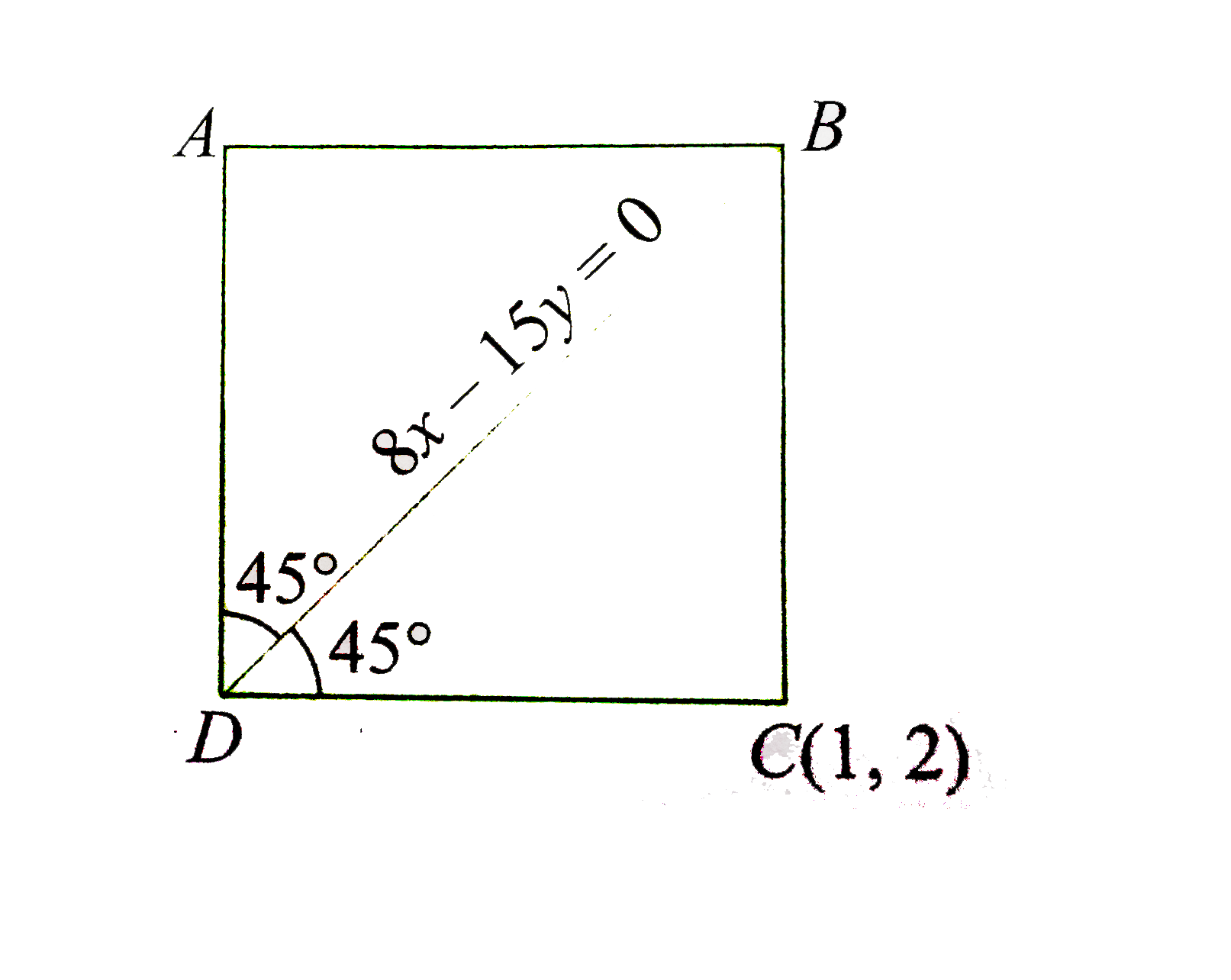One diagonal of a square is along the line and one of its vertex is (1, 2). Then the equations of the sides of the square passing through this vertex are (d)none of theseSolution in Bengali
7x-8y+9=0, 8x+7y-22=0
9x-8y+7=0.8x+9y-26=0
23x-7y-9=0,7x+23y-53=0
none of these
The correct Answer is:C

The slope of BD is 8/15 and the angle made by BD with DC and BC is . So, let the slope of DC be m. Then,
Hence, the equations of DC and BC are
or 23x-7y-9=0
or 7x+23y-53=0
Topper's Solved these Questions
- STRAIGHT LINESBook:CENGAGE PUBLICATIONChapter:STRAIGHT LINESExercise:EXERCISE (MULTIPLE CORRECT ANSWERS TYPE)
Explore 30 Videos
- STRAIGHT LINESBook:CENGAGE PUBLICATIONChapter:STRAIGHT LINESExercise:EXERCISE (LINKED COMPREHENSION TYPE)
Explore 27 Videos
- STRAIGHT LINESBook:CENGAGE PUBLICATIONChapter:STRAIGHT LINESExercise:CONCEPT APPLICATION EXERCISE 2.6
Explore 5 Videos
- STRAIGHT LINEBook:CENGAGE PUBLICATIONChapter:STRAIGHT LINEExercise:Multiple Correct Answers Type
Explore 8 Videos
- THEORY OF EQUATIONSBook:CENGAGE PUBLICATIONChapter:THEORY OF EQUATIONSExercise:JEE ADVANCED (Numerical Value Type )
Explore 1 Video
Similar Questions
If P is a point (x,y) on the line y=−3x such that P and the point (3, 4) are on the opposite sides of the line 3x−4y=8, then x>815 (b) x>85 y<−85 (d) y<−815
View SolutionLet l be the line belonging to the family of straight lines (a+2b)x+(a−3b)y+a−8b=0,a,b∈R, which is farthest from the point (2,2), then area enclosed by the line L and the coordinate axes is
View SolutionIf aandb are two arbitrary constants, then prove that the straight line (a−2b)x+(a+3b)y+3a+4b=0 will pass through a fixed point. Find that point.
View SolutionThe point P(α,α+1) will lie inside the triangle whose vertices are A(0,3),B(−2,0) and C(6,1) if
View SolutionThe number of distinct real roots of x4−4x3+12x2+x−1=0is_____.
View SolutionSolve the system of equation :11x+15y+23=0,7x-2y-20=0
View SolutionOne diagonal of a square is along the line 8x−15y=0 and one of its vertex is (1, 2). Then the equations of the sides of the square passing through this vertex are 23x+7y=9,7x+23y=53 23x−7y+9=0,7x+23y+53=0 23x−7y−9=0,7x+23y−53=0 none of these
View Solutionif (23^(9)-23^(8))/(22)=23^(x) then x=?
View SolutionThe point (−4,5) is vertex of a square and one of its diagonal is 7x−y+8=0. The equation of other diagonal is 7x−y+23=0 7y+x+=30 7y+x=31 x−7y=30 x+7y+31=0
View SolutionThe remainder when 23^(23) is divided by 53 is
View SolutionSolve the given pair of equations:
23x−29y=98 ,
29x−23y=110
View Solutionसिद्ध कीजिए कि -
√3cos23∘−sin23∘=2cos53∘
View Solution23 23 29 53 113 ?
View SolutionThe ratio in which the line x+y -1 =0 divides the line segment joining the origin and the point of intersection of the lines represented by
2x2−13xy−7y2+x+23y−6=0 is
View SolutionIf the lines 2x+3y+1=0 and 3x−y−4=0 lie along diameters of a circle of circumference 10π ,then the equation of the circle is (A) x2+y2−2x+2y−23=0 (B) x2+y2+2x−2y−23=0 (C) x2+y2+2x+2y−23=0 (D) x2+y2−2x−2y−23=0
View SolutionOne diagonal of a square is along the line 8x−15y=0 and one of its vertex is (1, 2). Then the equations of the sides of the square passing through this vertex are (a)23x+7y=9,7x+23y=53 (b)23x−7y+9=0,7x+23y+53=0 (c)23x−7y−9=0,7x+23y−53=0 (d)none of these
View Solution
